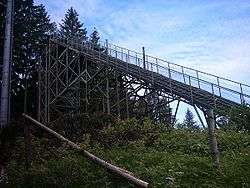Scheidegg, Bavaria
| Scheidegg | ||
|---|---|---|
| ||
 Scheidegg | ||
Location of Scheidegg within Lindau district  | ||
| Coordinates: 47°34′56″N 09°50′56″E / 47.58222°N 9.84889°ECoordinates: 47°34′56″N 09°50′56″E / 47.58222°N 9.84889°E | ||
| Country | Germany | |
| State | Bavaria | |
| Admin. region | Schwaben | |
| District | Lindau | |
| Government | ||
| • Mayor | Ulrich Pfanner | |
| Area | ||
| • Total | 27.40 km2 (10.58 sq mi) | |
| Population (2015-12-31)[1] | ||
| • Total | 4,226 | |
| • Density | 150/km2 (400/sq mi) | |
| Time zone | CET/CEST (UTC+1/+2) | |
| Postal codes | 88175 | |
| Dialling codes | 08381 (Scheidegg) 08387 (Scheffau) | |
| Vehicle registration | LI | |
| Website | www.markt-scheidegg.de | |


Scheidegg is a municipality in the district of Lindau in Bavaria in Germany and a licensed Kneipp cure spa and air health resort.
Geography
Located in the Westallgäu region, the municipality of Scheidegg consists of the town of Scheidegg and the district of Scheffau. On the west and south, the municipality borders on the Bregenz Forest, which is part of the Austrian state of Vorarlberg.
History
The settlement of the area around Scheidegg started most likely in the 6th and 7th century by the Alamanni. Until 1481 it belonged to Weiler and was - as a result of the loss of the document - first mentioned in 1255 in St. Gallen. The imperial abbey of Benedictines St. Gallen promoted christianity and culture. In 1296 abbot Wilhelm sold Scheidegg to Count Hugo of Bregenz (Montfort). The area, which Habsburg had purchased in 1571, stayed a part of Vorarlberg until the Treaty of Pressburg in 1805 (Napoleon) and later became a part of Bavaria.
The tradition of Scheidegg as a spa and recreation area goes back to the turn of the century (to the 20th century). When the first summer visitors came to Scheidegg after the construction of the railway line from Röthenbach to Scheidegg, the first attempt to organize the tourism was made by founding the association for transport and beautification in 1902. When in 1912 the construction of the Prinzregent-Luitpold-Kinderklinik (a paedriatic clinic) began, this was the cornerstone for the development of Scheidegg to a spa. In 1936 Scheidegg became a licensed air health resort. After World War II a new start had to be made. The necessity to qualify as a spa was soon acknowledged and hence the first licensed kneippism business formed in 1964.
In the year 1972 the municipalities of Scheidegg und Scheffau were merged in the course of the municipal reform in Bavaria.
Tourism
Scheidegg has a capacity of about 3.200 guests. Every year about 450,000 accommodations are registered. Consequently Scheidegg belongs to the 10 largest spas and tourist resorts in the area of Allgäu/Bavarian-Swabia.
Culture and sights
The Catholic parish church St. Gallus with paintings of Ludwig Glötzle from Munich and the evangelic resurrection church with an accessible maze can be found in the centre of the town. Scheidegg has 13 chapels in its proximity, among them one ecumenical. All the chapels are connected with the churches mentioned above and the Kreuzberg by the small and large ecumenical chapel route, which is unique in Germany. Scheidegg is located at the Westallgäuer Käsestraße (Westallgäu cheese route) and the local alpine dairy in the district of Böserscheidegg can be visited, including a tasting (amongst others Allgäuer Emmentaler). Also worth seeing: the reptile zoo, the museum of local history and the Scheidegger Wasserfälle (Scheidegg waterfalls). There are the "Original Scheidegger Wasserfälle", with service and parking lot, as well as the surrounding waterfalls: Hasenreuter Wasserfälle, Schwedenhöhle, Rickenbachfälle.
Notable people living in Scheidegg
References
- ↑ "Fortschreibung des Bevölkerungsstandes". Bayerisches Landesamt für Statistik und Datenverarbeitung (in German). June 2016.
